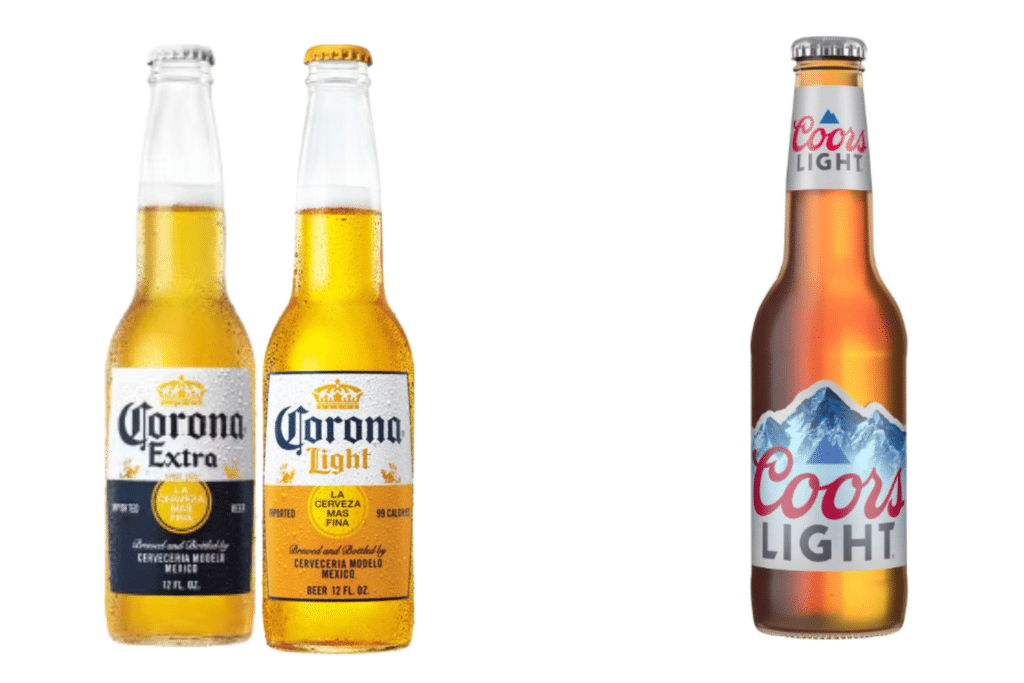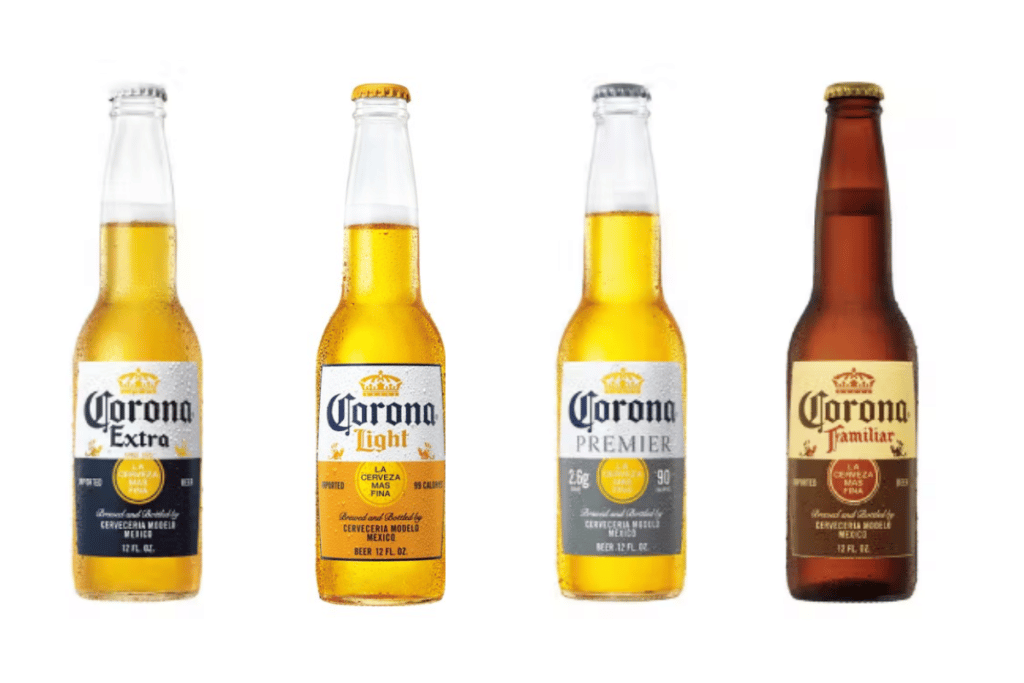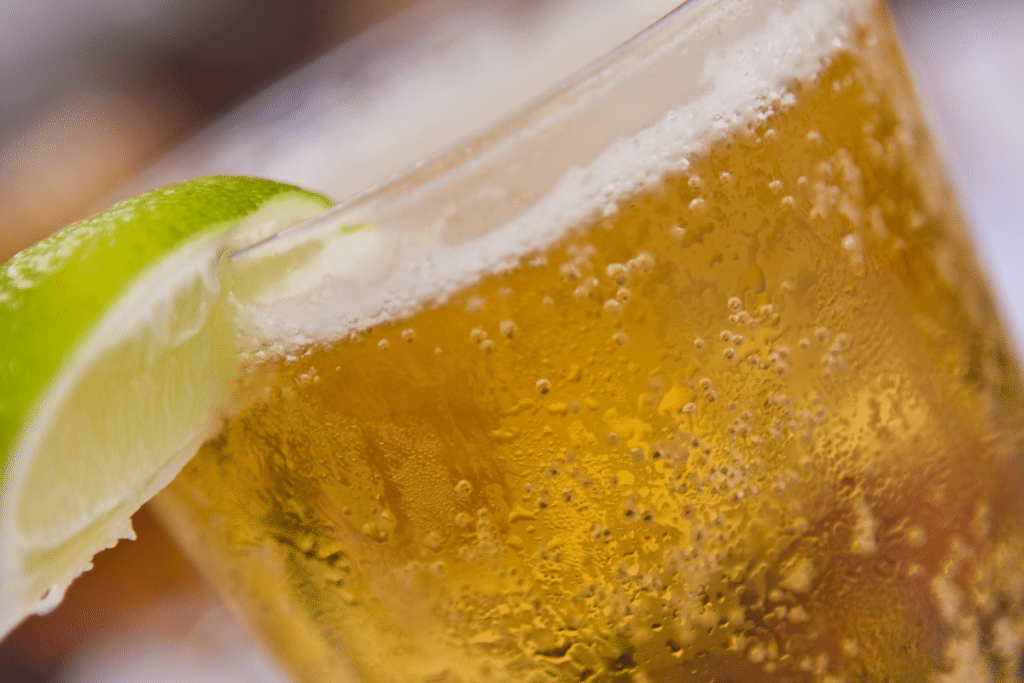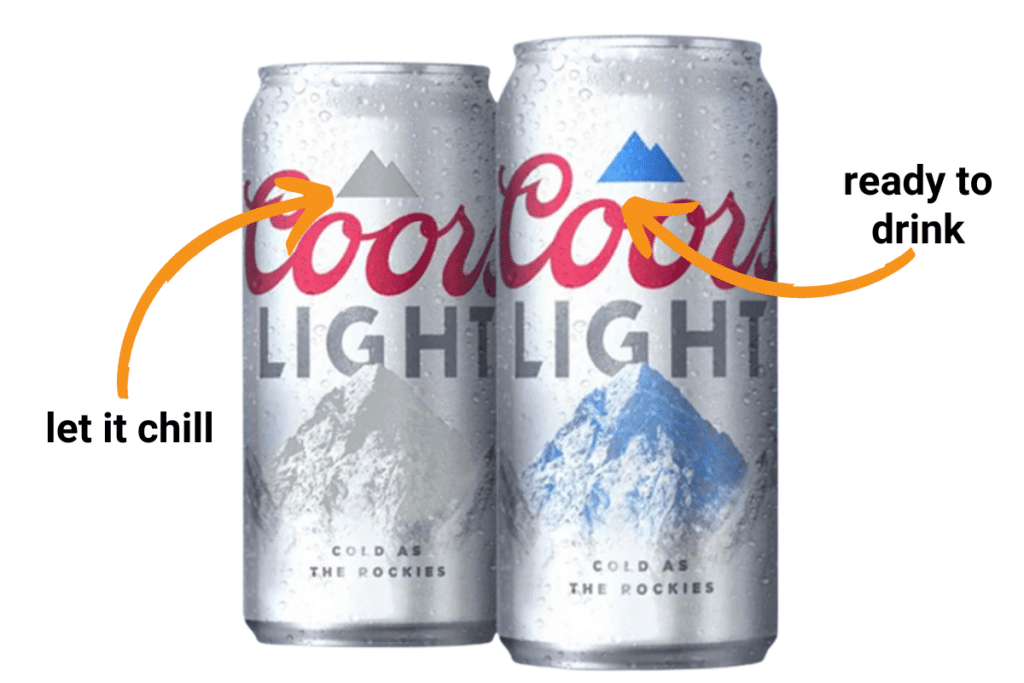Which do you choose from Corona Extra, Corona Light, and Coors Light? Each beer is great in its own right. The question is what are the differences between these three?
Corona Extra is a refreshing, well-balanced beer with hints of honey, fruit, and floral hop flavors. Both Corona Light and Coors Light have hops flavors; Corona Light has a light malt flavor, while Coors Light also has some bitterness. Unsurprisingly, Corona Extra has more calories and carbs than the others, although they all share a similar ABV.
Let’s break down each of the major differences between these great beers. From popularity to ingredients there is much to explore.
Topics We Cover
Corona vs Coors Light comparison overview
Between Mexican Lagers like Corona and American Adjunct Lagers such as Coors Light, there are plenty of delicious light beers. While these beers are united in their sessionability they are fairly different.

Corona Extra is a refreshing beer with hints of honey, fruit, and floral hop flavors. Overall it is well-balanced though it is commonly associated with skunky flavors. Like most Mexican lagers it is highly sessionable at 4.6% ABV.
Corona Light is a smaller beer than Corona Extra in terms of both ABV and flavor. It is designed to have low calories so that beer enthusiasts can enjoy a brew without worrying as much about calories.
Coors Light is a similarly light beer with notes of light malt with some sweetness to offset the bitterness. Coors Light is famous for its cold-activated cans which react to the preferred temperature to drink the beer.
| Comparison | Corona Extra | Corona Light | Coors Light |
| Calories | 148 | 99 | 102 |
| Carbs | 13.9 grams | 4.8 grams | 5 grams |
| ABV | 4.6% | 4.0% | 4.2% |
| Ingredients | Water, yeast, non-malted cereals, barley malt, hops, ascorbic acid, propylene glycol alginate (PGA) | Water, yeast, barley malt, non-malted cereals, hops | Water, barley, hop extract, lager yeast, corn syrup |
| Taste | Hints of honey, fruit, malt, floral | Notes of hops, light malt | Hints of malt, hints of bitterness |
| Aroma | Light bread, corn, skunk | Light malt | Light bready notes |
| Cost (6 pack) | $9.50-10 | $9 | $8 |
| Popularity (in popular opinion Q1 2023 US) | 15th | 12th | 14th |
| History | Introduced in the US in 1979 | First brewed in 1989 | First brewed in 1978 |
What is the difference between Corona and Coors Light?
When it comes to these beers there are many factors we can use to compare them.
Using the below aspects let’s break down the differences between Corona (both Light and Extra) and Coors Light:
- Corona vs Coors Light calories
- Corona vs Coors Light carbs
- Corona vs Coors Light alcohol content (ABV)
- Corona vs Coors Light ingredients
- Corona vs Coors Light taste, flavors, and aroma
- Cost
- Popularity and sales
- History
The first few aspects – calories, carbs, alcohol content, and ingredients – help to determine the objective differences between the recipe and the final product.
Then we can break down why people like one over the other. By covering the taste, flavors, and aromas of the two beers we can highlight some of the subjective reasons for people’s preferences.
Lastly, we’ll cover the marketing and history of the two beers. That will include the cost, popularity, and sales of both Corona beers and Coors Light.
Corona
Corona is owned by Anheuser-Busch InBev and brews several of the most popular Mexican lagers in the world.

In addition to the flagship Corona Extra and perennial favorite Corona Light, the brand also brews Corona Premier and Corona Familiar.
While Premier and Familiar are popular within their specific demographics, we will be looking specifically at the Light and Extra beers.
Calories, carbs, and other nutritional facts
Corona Extra is a full-bodied Mexican Lager with more calories, carbs, and a slightly higher ABV than Corona Light.
A 12-ounce can of Corona Extra contains 148 calories, 13.9 grams of carbs, 1.2 grams of protein, and 0 grams of fat.
For context, four Twizzler sticks have 160 calories. Another close comparison is that two double-stuff Oreos are 140 calories. To put it another way, drinking roughly 13.5 Corona Extras in one day is enough to reach 2,000 calories i.e., the recommended daily caloric intake for women.
A 12-ounce can of Corona Light contains 99 calories, 4.8 grams of carbs, 0.8 grams of protein, and 0 grams of fat.
It would take 20 bottles of Corona Light to reach that number of calories.
Alcohol Content (ABV)
It should come as no surprise that Corona Extra has a higher ABV than Corona Light, although the difference might be less extreme than you expect.
Each 12-ounce can or bottle of Corona Extra has 4.6% alcohol by volume (ABV) while Corona Light has 4.0% ABV.
At 4.6%, Corona Extra is a pretty typical lager. Most inebriation cheat sheets assume you’re drinking a 4.5% ABV beer so they should be quite accurate when drinking Corona Extra.
Corona Light on the other hand is, as the name implies, a very light beer. With only 4% ABV it is easily sessionable.
Ingredients
While the exact recipes are unknown, we do know the ingredients used to brew these popular lagers.
Corona Extra is brewed with 6 ingredients: water, non-malted cereals, barley malt, hops, ascorbic acid, and propylene glycol alginate (PGA). Corona Light has only 5 ingredients, leaving off the PGA and ascorbic acid.
Yeast is also used in the brewing process but is not listed in the ingredients.
Ascorbic acid or vitamin C is used to preserve the beer as it is an antioxidant. PGA is used in Corona Extra to stabilize the head.
Taste, flavors, and aroma
Both beers are refreshing, although Corona Extra has a more pronounced flavor and may be better with a good meal than relaxing on a hot day.
Corona Extra tastes faintly of fruit and honey with a balance between malt and hop flavors. The mouthfeel is light with decent carbonation and a short finish. Corona Light is lighter on the flavors. Light malt flavors are the dominant notes however diminished they are.

If either beer has been directly exposed to too much sunlight it can develop a “skunky” flavor and aroma. For this reason, Corona is often served with a lime wedge.
Cost
A 6-pack of 12-ounce Coronas costs roughly $8 to $10. This price is dependent on your region. At a bar, you might find a Corona Extra for $6.
At a liquor store, you will find Corona in plenty of different packaging options. You’ll find 6-packs, 12-packs, 24-packs, and other sizing options such as 16-ounce cans. These options can range from as cheap as $6 to as expensive as $30.
Popularity and sales
According to YouGov America, Corona Extra is the 15th most popular beer in the US for Quarter 1 of 2023. It has a popularity score of 42% and a fame score of 91%. Corona Light is the 12th most popular with a score of 42%. Its fame score is 95%.
The popularity score is based on Americans that have a positive opinion of Corona. On the other hand, the fame score is based on the percentage of Americans who have heard of the beer.
In recent years, Corona sales have actually increased in America. This increase began in 2020 and seems to be related to the fact that the beer’s name is similar to the coronavirus.
As a Mexican lager, Corona Extra is one of many great beers. If you enjoy Corona Extra, you may enjoy some of these beers.
History
Corona Extra was first brewed in 1925 in Mexico City. At this time it was simply Corona. By 1935 Grupo Modelo began marketing the brew as Corona Extra.
In the mid-1900s, US surfers and tourists who visited Mexico began bringing the beer home with them. By 1979, Corona Extra was officially introduced to the US. Corona Extra has been one of the top-selling imports in the US since then.
In 1989, Corona Light was born. This lighter version of Corona Extra was designed to appeal to those watching their caloric intake.
Over the many years of Corona, Grupo Modelo has brewed many varieties of the beer.
Coors Light
Coors Light is a powerhouse light beer owned by Molson Coors.
Coors Light was first brewed in 1978 as the light version of Coors Banquet. It was brewed to compete with other light beers at the time and was immediately successful, eventually becoming more popular than the original Coors.
Coors Light has always been known for its “silver bullet” can, but did you know that the packaging is actually designed with passionate beer drinkers in mind? Whether you prefer your beer from a bottle or a can, watch the mountain range – once it hits the ideal drinking temperature, the mountain will turn blue.
Calories, carbs, and other nutrition facts
“Light” beers are typically around 100 calories, and Coors Light is no exception.
A 12-ounce Coors Light has 102 calories, 5 grams of carbs, 0 grams of fat, and fewer than 1 gram of protein.
At 102 calories, a Coors Light has a little more calories than one and a half bananas.
Alcohol Content (ABV)
Each 12-ounce can of Coors Light has 4.2% alcohol by volume (ABV).
The standard ABV for a beer when calculating inebriation is 4.5%. Since Coors Light is close to this you can use an inebriation cheat sheet to determine how many drinks before you shouldn’t drive. It is always wise to err on the side of caution.
Ingredients
As with most major brewing companies, Coors keeps the exact details of how Coors Light is brewed a secret, but we do know a good bit about the ingredients.
Coors Light is brewed with Rocky Mountain spring water, North American 2-row barley, hop extract, lager yeast, and corn syrup. Most breweries do not list yeast as an ingredient because it is often filtered out of the final product.
Two-row malts are used to bring out strong malt flavors. To accentuate this, the beer is cold lagered and filtered.
Taste, flavors, and aroma
Being one of the top beers in the country, you might expect Coors Light to have a bold, distinctive flavor.
Coors Light’s dominant flavor is malt. There is also a hint of hop bitterness to offset the sweetness. The aroma is similar to the flavor profile.
The mouthfeel is fairly watery, almost like mineral water. There is still a decent level of carbonation, however, and is not as dry as other light beers. It leaves no lingering aftertaste.
Check out this article for more details on the taste, aroma, and mouthfeel of Coors Light.
Cost
A 6-pack of 12-ounce Coors Lights costs roughly $8 though it may be cheaper or more expensive depending on your area. On draught, at a bar, you might see a pint for roughly $5.

Coors Light is available in plenty of packaging sizes at various prices. You can find 12-packs, 24-packs, and even ½ kegs.
Popularity and sales
Coors Light is the 14th most popular beer of Quarter 1, 2023 in the US. It has a popularity score of 42% with a fame score of 94%.
The popularity score is based on Americans that have a positive opinion of Coors Light. On the other hand, the fame score is based on the percentage of Americans who have heard of the beer.
History
The Coors Light we know today is not the first beer of the name, but it’s certainly the most enduring. In the 1940s Coors Brewing Co. sold a different light beer; however, this brew was discontinued and not sold after World War II.
The beer we know as Coors Light was first brewed in 1978 and began being sold throughout the United States in 1991. In 2005, it (perhaps appropriately) won the silver award in the Great American Beer Festival.
In 2005, it was named the official beer of NASCAR.

